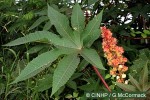Cook Islands Biodiversity Database
Species Page
Ricinus communis
Tuitui Papa‘āCastor-bean Tree
Multimedia & Additional Resources
| Type | Description | Download |
| Leaves and flowers | 86KB |
General Information
Cook Islands Distribution
| Southern Group: Present Makatea: Present | ||||||||
RR |
MG |
AT |
MK |
MT |
AK |
PL |
TK |
MN |
+L |
++ |
+L |
- |
- |
- |
- |
- |
|
| Northern Group: - | |||||
TN |
MH |
RK |
PK |
NS |
SW |
- |
- |
- |
- |
- |
- |
Scientific Taxonomy
Ricinus communis Linnaeus
TAXONOMY: PLANTAE; ANTHOPHYTA (=Angiospermae); MAGNOLIOPSIDA (=Dicotyledones); ROSIDAE; Euphorbiales; EUPHORBIACEAE
More Information
GENERAL NOTE: ACSm syas probably an Abo Intro to Fiji. The seeds are sometimes eaten for the purgative action of their caster oil, But this is a very dangerous practise as they contain a poison called ricin, which resembles snake venom. If the poison enters the bloodstream through a cut or sore in the mouth or intestines it can cause a loss of appetite for several days, followed by emesis, diarrhea, delirium, collapse and death. (Arnold 1968)
Vouchers & References
Vouchers:
None Recorded.
References:
p.629 Wagner et al.- Flowering Plants of Hawaii
p.509 Neal - In Gardens of Hawaii
p.428 Tropica
p.2/499 A.C.Smith - Flora Vitiensis Nova
p.295 R* Cheeseman - Flora of Rarotonga
p.68 Wilder - Flora of Rarotonga
p.408g Whistler - Ethnobotany of the Cook Islands
Data Update History (information):
zTX, zB02, zM02
Web Resources
Citation Information
McCormack, Gerald (2007) Cook Islands Biodiversity Database, Version 2007.2. Cook Islands Natural Heritage Trust, Rarotonga. Online at http://cookislands.bishopmuseum.org. ![]()
Please refer to our use policy.

